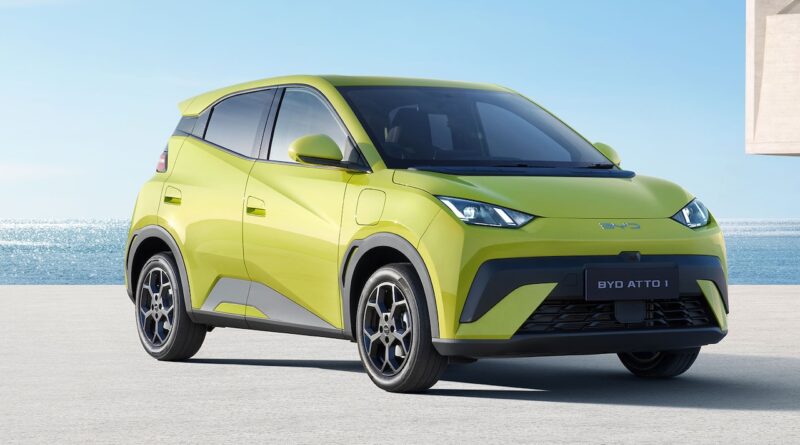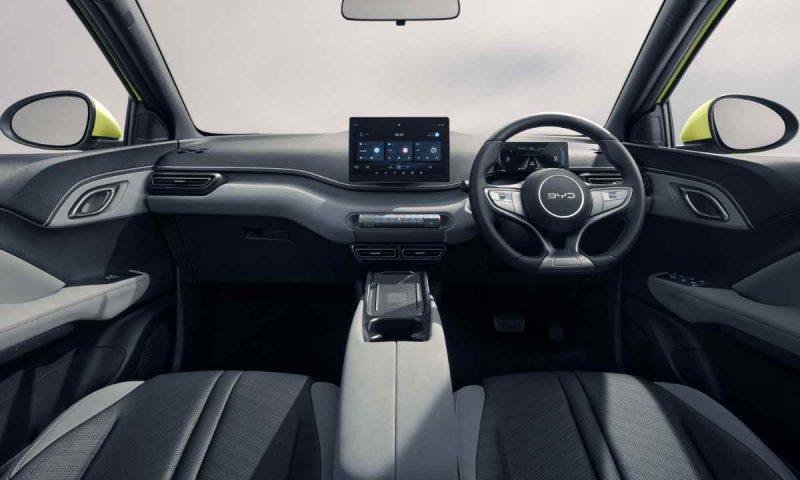
BYD Australia has confirmed it will bring the compact Atto 1 city hatch to local showrooms – the same car marketed overseas as the Seagull (China) and the Dolphin Surf (UK) – promising that it will become “Australia’s most affordable EV by some margin.” The announcement, made alongside confirmation that the slightly larger Atto 2 small SUV will arrive at the same time, signals a deliberate push by BYD to expand its price-competitive line-up in Australia and to broaden appeal beyond its existing SUV-heavy portfolio.
What BYD is bringing: models and positioning
- Atto 1 (Seagull / Dolphin Surf): A dedicated city hatch positioned beneath the BYD Dolphin in price and size. At 3,780 mm long and 1,750 mm wide, it sits between micro and small‑car segments – larger than a Kia Picanto but smaller than a Mazda 2. BYD Australia has publicly stated its intention for the Atto 1 to claim the title of Australia’s cheapest EV, aiming to attract first‑time EV buyers and fleet operators looking for low-cost entry points.
- Atto 2: A small SUV that will join the Atto family in Australia with two grades – ‘Essential’ and ‘Premium’ – and a single motor 130 kW / 290 Nm powertrain paired with a BYD Blade LFP battery (51.13 kWh). It sits as a direct rival to compact EVs such as the Hyundai Kona Electric and Kia EV3.
- Sealion 5 PHEV and Sealion 8 PHEV: BYD has also flagged mid‑size and large plug‑in hybrid SUVs – including a seven-seat Sealion 8 – for early 2026, bringing more variety to its local range.
- Denza: BYD’s premium sister marque is slated to debut in Australia with the Denza B5 and B8 plug‑in hybrid 4WD SUVs as the brand’s opening models.
Technical highlights and trim expectations
- Atto 1 powertrain: In China the Atto 1 uses a single front‑wheel motor producing 55 kW and 135 Nm, coupled with BYD’s Blade LFP cells offered in roughly 30-39 kWh capacities. UK offerings use 30 kWh and 43.2 kWh packs with WLTP ranges of roughly 220 km and 321 km respectively – figures that give a useful benchmark for what Australians can expect from small‑battery urban EVs.
- Interior and features: Internationally the entry Atto 1 is a modestly equipped city car with 15‑inch wheels, ‘vegan leather’ seat trim, and a rotatable 10.1‑inch infotainment screen supporting Apple CarPlay/Android Auto and navigation. Higher grades add larger batteries, 16‑inch alloys, heated seats, wireless charging and 360‑degree cameras.
- Atto 2 battery and range: BYD has confirmed the Atto 2 will use a 51.13 kWh BYD Blade LFP battery in Australia. Overseas versions with slightly smaller 45.1 kWh packs have quoted WLTP ranges around 312 km; the local 51.13 kWh unit should drive range higher, though local WLTP/ADR figures will be confirmed closer to launch.

Pricing – what to expect
BYD has been explicit it wants the Atto 1 to be the lowest‑priced EV available in Australia. Using international price spreads and the current local BYD lineup for context:
- In China the equivalent Seagull is priced in the local market at the very low end (the original article referenced prices from roughly ¥69,800-¥85,800), and in the UK the Dolphin Surf has been positioned at roughly two‑thirds the price of the Dolphin hatch.
- BYD Australia says the Atto 1 will be positioned below the BYD Dolphin’s current Australian entry price (the Dolphin initially started from around $29,990 before on‑road costs). Industry observers therefore suggest retail pricing could be substantially undercutting the $30,000 threshold – with analyst estimates often quoted in a broad band between approximately $20,000 and $28,000 before on‑road costs, depending on specification, local options, and freight/tariff adjustments.
A note on conversions and reality checks: direct currency translations are unreliable. Import costs, Australian compliance testing, optional equipment and dealer margins all affect the final price. BYD’s public claim that the Atto 1 will be “most affordable… by some margin” should be read in the context of aggressive global pricing strategies from Chinese brands, and will be validated only when official local pricing is released.
Market implications for Australia
- Entry‑level EV adoption: A sub‑$30k (and potentially sub‑$25k) factory‑new EV from a major volume brand would materially expand electrification options for budget‑conscious buyers and small fleets. It would also put immediate pricing pressure on legacy makers and other Chinese entrants offering low‑cost EVs.
- Battery technology and safety: BYD’s use of Blade LFP cells reinforces the industry trend favouring LFP chemistry for city and mid‑range EVs: lower cost, better thermal stability and longer cycle life compared with some NMC cells, though typically with lower gravimetric energy density. For many urban buyers the trade‑off is acceptable, and LFP batteries have become mainstream in global and Australian EV offerings.
- Charging and range expectations: The Atto 1’s modest battery and city focus reduce reliance on high‑speed public charging for typical daily use. However, consumers must weigh shorter WLTP ranges (relative to larger SUVs) against price, and consider access to home charging or workplace power to maximise the real‑world utility of a small‑battery EV.
Supply, warranty and aftersales
BYD’s success in Australia to date has been helped by dealer expansion and competitive warranty packages on other models. Prospective Atto 1 buyers should verify:
- Warranty length for vehicle and battery (BYD’s current Australian warranty terms on other models are a useful reference point but may differ by model and over time).
- Availability of BYD service centres and certified technicians in their state or territory.
- Options for pre‑purchase test drives and demonstrator units to assess the model’s real‑world suitability.
Timing and availability
BYD’s announcement indicated a near‑term launch for these models, with the Atto 1 and Atto 2 arriving before the mid‑2026 timeframe in which BYD expects to broaden its local range further. As always, exact availability will depend on regulatory approvals, shipping and local compliance testing. Prospective buyers should watch BYD Australia’s official channels and authorised dealers for final spec sheets, pricing, and booking options.
What buyers should consider
- Use case: The Atto 1 is designed for short urban commutes and first‑time EV buyers. If you regularly travel long distances or require towing capacity, consider larger‑battery alternatives.
- Running costs: Lower purchase price plus LFP battery durability can translate into attractive total cost of ownership, particularly in urban fleet applications.
- Resale and incentives: Check state schemes for registration discounts, stamp duty concessions or EV incentives (where applicable). Also monitor the evolving second‑hand EV market, where higher volumes of affordable new EVs are likely to influence future resale values.
Conclusion
BYD’s decision to import the Atto 1 to Australia is strategically significant. If local pricing matches the brand’s global undercutting strategy, the Atto 1 could materially lower the entry gate for EV ownership in Australia and accelerate adoption among budget buyers and fleets. Its arrival, together with the Atto 2 and upcoming Denza models, demonstrates BYD’s intent to cover a wide cross‑section of the Australian market – from affordable city hatches to premium PHEV SUVs.
Buyers should await confirmed local specifications, warranty details and final pricing, and weigh the Atto 1’s urban focus, battery chemistry (LFP), and expected equipment levels against their practical needs. For government and industry stakeholders, a genuinely low‑cost, mass‑market EV would increase pressure to upgrade charging infrastructure and to ensure aftersales support keeps pace with growing EV volumes.
FAQs
When will the BYD Atto 1 be available in Australia?
BYD Australia has signalled a near‑term arrival for the Atto 1 alongside the Atto 2, but final retail availability and dealer allocations will be confirmed by BYD and authorised dealerships once compliance testing and local adjustments are complete. Watch BYD Australia’s official communications for exact dates and booking windows.
How much will the Atto 1 cost in Australia?
BYD has stated the Atto 1 will be the country’s most affordable EV “by some margin.” Industry estimates place potential pricing in a broad band that could undercut the $30,000 mark and – depending on specification – approach the low‑$20,000s before on‑road costs. Official local pricing will be announced by BYD.
What driving range can buyers expect from the Atto 1?
Internationally, small battery options for the Atto 1 produce WLTP ranges in the order of 200-320 km, depending on battery size. Australian versions are expected to offer a similar spectrum, but final ADR/WLTP figures for local models will be provided by BYD at launch.
Is the Atto 1 safe and reliable?
The Atto 1 uses BYD’s Blade LFP battery chemistry, which is widely regarded for thermal stability and longevity. Safety ratings will depend on Australian testing and independent assessments; buyers should review ANCAP ratings (once available), local dealer information, and warranty terms before purchase.
How does the Atto 1 compare with other affordable EVs?
Positioned below the BYD Dolphin and competing with low‑cost EVs from other brands, the Atto 1’s strengths are price, urban suitability and BYD’s Blade battery technology. Buyers should compare real‑world range, feature levels, charging speed, warranty and dealer support when evaluating alternatives.
Should I wait for the Atto 1 or buy a different EV now?
If you need an EV immediately, existing models from BYD and other manufacturers remain competitive. If price is the primary constraint and you can wait for final Australian pricing and test drives, the Atto 1 may offer a more affordable entry to EV ownership. Consider your commute, charging access and financing timeframe when deciding.
About EV Evolution
EV Evolution is the leading online platform dedicated to Australian electric vehicle owners and enthusiasts. We foster a vibrant community, delivering essential EV news and insights, and enhancing user engagement through our innovative, AI-powered chatbot for dynamic discussions. Our mission is to empower Australian electric vehicle owners and enthusiasts by fostering a vibrant, AI-driven online community that connects, informs, and advances the nation’s electric vehicle landscape.




